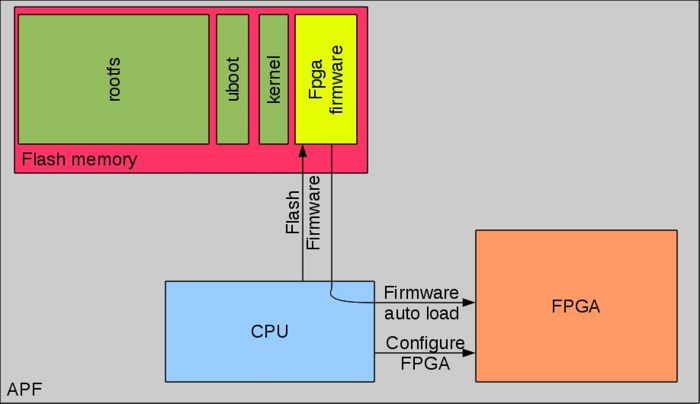Difference between revisions of "Configure or flash FPGA ?"
From ArmadeusWiki
| Line 1: | Line 1: | ||
| + | This article explain the difference between flashing FPGA and configuring FPGA. | ||
| + | |||
[[image:flash_configure_fpga.jpg|700px|center|thumb|'''figure 1''' - ''Flash and FPGA'']] | [[image:flash_configure_fpga.jpg|700px|center|thumb|'''figure 1''' - ''Flash and FPGA'']] | ||
| + | |||
| + | * '''Configure''' FPGA : At power on, the FPGA is not configured. FPGA '''configuration''' is the action of transfering the bitstream from the processor RAM to the FPGA. | ||
| + | * '''Flash''' FPGA : It is possible to save the FPGA configuration under the Flash memory of the APF. Flashing FPGA is the action of transfering the bitstream from the processor RAM to the FPGA. | ||
| + | * '''Auto-load''' : It is possible to configure U-Boot to '''configure''' the FPGA with the configuration saved in Flash memory on the boot. To do that simply set the U-Boot environment variable '''firmware_autoload''' to 1 : | ||
| + | <pre class="apf"> | ||
| + | BIOS> setenv firmware_autoload 1 | ||
| + | BIOS> saveenv | ||
| + | </pre> | ||
Revision as of 14:23, 12 January 2012
This article explain the difference between flashing FPGA and configuring FPGA.
- Configure FPGA : At power on, the FPGA is not configured. FPGA configuration is the action of transfering the bitstream from the processor RAM to the FPGA.
- Flash FPGA : It is possible to save the FPGA configuration under the Flash memory of the APF. Flashing FPGA is the action of transfering the bitstream from the processor RAM to the FPGA.
- Auto-load : It is possible to configure U-Boot to configure the FPGA with the configuration saved in Flash memory on the boot. To do that simply set the U-Boot environment variable firmware_autoload to 1 :
BIOS> setenv firmware_autoload 1 BIOS> saveenv
